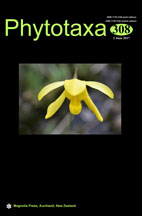Abstract
Pond populations in Cape Cod described as Persicaria puritanorum (≡ Polygonum puritanorum) have been treated by recent authors as a synonym of P. maculosa (≡ Polygonum persicaria) based on gross morphology. However, consistent differences in leaf and inflorescence features raise the question as to whether this is an extreme phenotype of P. maculosa, an ecotype of that species, or a distinct taxon. In this study, we analyzed nuclear ITS region and chloroplast matK region DNA sequences from 37 populations of 11 species within section Eupersicaria and counted the chromosome number of individuals from the pond populations in question. We also compared leaf size and shape of plants from these populations with those of the typical P. maculosa plants by measuring selected herbarium specimens. Phylogenetic trees inferred from sequence data indicate a separation of pond populations from P. maculosa suggesting to recover P. puritanorum as a distinct species. Chromosome counts of pond population plants (2n = 60) strongly support this result, and furthermore suggest the possibility of a hybrid polyploid origin of P. puritanorum. A leaf morphological trait (greater relative height of the maximum width point from the leaf base) also supports the separation of pond populations from P. maculosa. P. punctata allied to P. hydropiper in the ITS-based tree, and to pond populations as well as P. hydropiperoides and P. opelousana in the matK-based tree, suggesting the possibility of hybrid origin of P. punctata. Our ITS sequence analyses also reveal distinct two lineages in P. lapathifolia but the chloroplast matK region sequences of P. pensylvanica and two lineages of P. lapathifolia are almost identical suggesting cytoplasmic introgression or allopolyploid speciation sharing the maternal lineage.

